- What Is Phosphorus?
- Why Does Cat Food Contain Phosphorus?
- How Much Phosphorus Do Cats Need?
- Are There Upper Phosphorus Limits?
- Can a High Phosphorus Diet Harm My Cat?
- Should Senior Cats Eat a Low Phosphorus Diet?
- How To Find the Phosphorus Content of Your Cat’s Food
- How Do I Choose a Diet for My Cat?
- Frequently Asked Questions
Phosphorus is an essential nutrient required by the body. However, high phosphorus intake through the diet is known to worsen the state of kidney disease in cats. Very recently, concerns have also arisen that diets high in phosphorus may contribute to the development of kidney disease in healthy cats.
In this article, you’ll learn more about phosphorus, why it is included in cat food, the latest research information on the association between high phosphorus diets and kidney disease, and some frequently asked questions.
Also Read: What’s The Best Food For Cats With Kidney Disease?
What Is Phosphorus?
Phosphorus is an essential mineral, present naturally in many foods. It is required for growth and repair of all tissues and for the production of DNA. Phosphorus is also needed to balance and assist with the use of other vitamins and minerals in the body including vitamin D, iodine, magnesium, and zinc.
The body seeks to keep phosphorus in balance with calcium. Within the body, calcium and phosphorus should be about equivalent in a ratio close to 1:1. Allowances can see calcium be higher at 2:1, but this ratio should never drop below 1:1. In other words, phosphorus should never be higher in the body than calcium.
Also Read: The Complete Feeding Guide From Kittens To Seniors
Why Does Cat Food Contain Phosphorus?
Phosphorus is commonly found in high protein foods such as meat.
Phosphorus can be divided into two main types: organic and inorganic. Organic phosphorus is phosphorus present naturally in many foods, but especially in grains and high protein foods like meat. As obligate carnivores, cats need a high protein content, and commercial cat foods (wet and dry food) often include high protein levels.
Canned cat food or wet foods that have higher proportions of meat content will naturally have higher levels of organic phosphorus. Raw diets composed primarily of meat and bone products will also have higher levels of organic phosphorus.
Inorganic phosphorus, at least in chemical terms, is when phosphorus is bound to another mineral like calcium, sodium, or magnesium. Inorganic phosphorus is also referred to as phosphate because of how it is bound to other minerals. Phosphates are most often included in foods as preservatives to extend shelf life and to add texture to foods to make them more enticing to eat. Examples of inorganic phosphorus include calcium monophosphate, sodium monophosphate and sodium dihydrogen phosphate.
Also Read: 7 Best Human Grade Cat Foods
How Much Phosphorus Do Cats Need?
The AAFCO set recommended requirements for nutrients such as phosphorus.
The minimum amount of dietary phosphorus needed by cats has been researched a lot over time, has been established by the National Research Council (NRC) and is published in The Nutrient Requirements of Dogs and Cats from 2006. The NRC recommended daily allowance (RDA) is the basis upon which many pet diets are formulated.
The Association of American Feed Control Officials (AAFCO) bases its own nutrient guidelines on the NRC publications, though AAFCO provides updates more often. While pet food companies are not required to follow AAFCO guidelines on their own, many states have incorporated AAFCO feeding guidelines into law that help regulate how diets are formulated and manufactured.
The NRC and AAFCO both express their nutrient requirements a little differently which can be confusing, but in both cases they are expressed in a way that allows diets to be compared better to each other. The NRC expresses nutrients as grams per 1000 kilocalories of metabolizable energy (g/1000kcal ME).
AAFCO expresses nutrients both as the NRC does, as well as a percentage of dry matter (%DM). Percentage of dry matter standardizes comparison of diets by assuming all moisture content has been removed so that they can be compared on what is called a dry matter basis.
For the NRC, guidelines for feeding phosphorus are the following for adult cats and kittens:
- Adult Cats: Recommended Daily Allowance: 0.6g/1000kcal ME
- Minimum Allowance: 0.4g/1000kcal ME
- Kittens: Recommended Daily Allowance: 1.8g/1000kcal ME
- Minimum Allowance: 1.2g/1000kcal ME
For AAFCO, guidelines for feeding phosphorus are the following for adult cats and kittens:
- Adult Cats: Minimum Allowance: 0.5% dry matter 1.25g/1000kcal ME
- Kittens: Minimum Allowance: 0.8% dry matter 2.0g/1000kcal ME
Nutritional requirements vary with different lifestages, to optimize health and wellness. You probably noticed that recommended phosphorus amounts are higher for kittens versus adults. This is due to how much more phosphorus is needed for development of bone and tissues in these growing animals. For pregnant queens, feeding amounts are similar as for kittens, since they are supporting the growth of one or more kittens.
There are no specific guidelines for senior cats as their nutritional needs can vary a lot. The interpretation of dietary needs for senior cats likewise varies quite widely among pet food manufacturers.
The true dietary needs of any senior cat depends largely on their state of health and any disease states they have that require dietary change. As an example, a healthy 7 year old cat who is considered a “senior” may be just as healthy as when they were 6 years old and considered an “adult”. But a 15 year old senior cat with kidney failure, heart disease, or diabetes paints a very different picture for nutritional needs.
You may have also noticed in the guidelines that there are no maximum levels of phosphorus that are advised. And herein lies the concern we’ll be talking more about.
Also Read: How Much Should Cats Eat And How Often
Are There Upper Phosphorus Limits?
There are no specific upper safe limits to dietary phosphorus that have been firmly established by the NRC, AAFCO, or FEDIAF, which is Europe’s AAFCO equivalent. However, the 2006 NRC publication provides a range of expected safe upper limits which is 2.5-3.5 g/1000kcal ME. This assumes an appropriate dietary ratio of calcium content to phosphorus content.
Can a High Phosphorus Diet Harm My Cat?
High dietary phosphorus levels have been linked to kidney disease in cats.
While phosphorus is an essential mineral, too much of it can definitely be detrimental. For many years, diets high in protein and phosphorus have been shown to worsen the state of existing chronic kidney disease (CKD) in cats. This has led to a main therapeutic approach of feeding a diet lower in dietary phosphorus and sodium with high-quality protein as well as a neutral pH for cats in renal failure.
CKD in cats is not a very well-understood process. Initially, research focused on the role of protein in renal disease, with some veterinary diets adopting a low protein approach to try and prevent progression from the early stages of kidney disease. Although there may be many different underlying causes that have nothing to do with diet, there has been a lot more research conducted to look at the effect of dietary phosphorus on the kidney health of otherwise healthy cats in just the last 4-5 years.
A landmark study published in 2018 set the ball rolling for further follow-up studies to look more closely at dietary phosphorus in cat foods. Published in the Journal of Feline Medicine and Surgery, researchers found that feeding a diet very high in phosphorus (about 5 times that of the recommended allowances by the NRC) to healthy cats showed markers of kidney damage were seen after only 30 days. The diets were freshly prepared, but calcium and sodium monophosphate were both used to reach the high phosphorus level.
The same year this study was published, petfoodindustry.com published a short article entitled “High phosphorus cat food may hurt kidneys”, citing recent findings from the study.
Since then, several other studies have come out looking at particulars of how dietary phosphorus may be impacting a cat’s kidneys and how high they would have to be to present a concern.
A couple of the same authors from the landmark study published another the same year looking at types of inorganic phosphates included in cat foods. Their findings supported that inorganic phosphates have a much higher bioavailability and absorption than organic phosphorus and that sodium monophosphate led to higher stress on the kidneys than calcium monophosphate.
In the British Journal of Nutrition, researchers found that feeding a diet with an inorganic phosphate content of 3.6g/1000kcal combined with a low calcium-to-phosphorus ratio led to changes in the kidneys and ill effects within 4 weeks. Interestingly, a normal calcium to phosphorus ratio did not lead to these changes. These findings highlighted the importance of not just the total phosphorus level in food, or how much is inorganic vs. organic, but also the balance of calcium and phosphorus in the diet.
The next year in 2019, a study published in the Journal of Veterinary Internal Medicine evaluating phosphorus content in commercially available cat foods presented the concerning findings that 33% of the 82 diets they analyzed had phosphorus content exceeding 3.6g/ 1000kcalME.
They also stated some of the following conclusions:
- High protein diet categories had a higher proportion of phosphorus above levels shown to cause kidney dysfunction in healthy cats.
- There were no correlations between non-traditional protein foods and phosphorus (foods containing exotic protein sources like kangaroo or rabbit).
- There were no correlations between canned foods alone and high phosphorus.
- An inverse ratio of calcium to phosphorus may indicate a higher proportion of inorganic phosphorus is included in the diet.
- 7 diets contained phosphorus greater than 4.8g/1000kcal ME, with most being raw diets containing high protein and bone derivatives.
- There was no correlation between diet price and higher or lower phosphorus foods.
The same year in 2019, a study published in Veterinary Medicine and Science looked more specifically at phosphorus content in commercial wet foods for cats. Researchers evaluated 35 commercial wet foods from Europe. All contained phosphorus (and sodium) levels above minimum requirements set by FEDIAF.
While exceeding minimum requirements is common to ensure adequate phosphorus intake, 5 of the 12 diets evaluated for cats exceeded the 3.6g/1000kcal of phosphorus that has been described in many of these research studies.
In 2020, researchers looked at different types and amounts of dietary phosphorus on the kidney health of cats, publishing their findings in the Journal of Veterinary Internal Medicine. Their main takeaway finding was that an inverse or low calcium-to-phosphorus ratio combined with use of highly soluble inorganic phosphates are associated with markers of kidney injury.
These researchers also concluded a couple of other important points:
- There was no evidence that universally connects commercial diets with kidney injury. However, some commercial diets contain high amounts of phosphorus relative to recommendations and have low calcium-to-phosphorus ratios.
- Increases in blood serum phosphorus occur when highly soluble phosphates containing sodium are added to diets in amounts equal to or greater than 0.5g of phosphorus per 1000kcal ME.
- Any association between dietary phosphorus and blood serum phosphate levels are weak. Serum phosphate represents only 1% of total body phosphorus, which can be affected by intestinal absorption and movement in and out of bones and cells.
- Bioavailability in sources of phosphorus can vary widely and the calcium to phosphorus ratio of a diet also affects phosphorus levels.
Also Read: Cat Calorie Calculator
Should Senior Cats Eat a Low Phosphorus Diet?
Currently, the effects of phosphorus on senior cats versus young adult cats have not been evaluated. However, the research studies we just reviewed looked at the effect of high phosphorus on healthy cats and a senior cat that has no diseases being treated may be just as healthy as an adult cat.
What is most important is to realize that older cats are more prone to developing chronic disease and early detection is key to better outcomes and longevity. If kidney disease is detected early either through the SDMA test or suspected from a low urine specific gravity, immediate efforts should be made to feed a low phosphorus cat food. Other interventions for renal support include maintaining hydration through increased water intake such as by changing from kibble to a wet diet.
How To Find the Phosphorus Content of Your Cat’s Food
Interpretation of dietary ingredients in commercial cat foods can be difficult.
Currently, finding out the phosphorus content in any pet’s diet is difficult. If you look at a pet food label, you can find the guaranteed analysis that includes the percentage of protein, fat, and carbohydrates. You will also find the ingredients list. However, unlike labels for human foods, there is no full breakdown of the percentages or amounts of vitamins, minerals, and other ingredients.
However, this is likely in the process of changing. According to a November 2022 article written by the Tufts University Cumming’s School of Veterinary Medicine Clinical Nutrition Service, AAFCO is proposing dramatic changes to pet food labels. The “Guaranteed Analysis” section on the label will be replaced by “Pet Nutrition Facts” that will have expressed amounts of individual ingredients. These changes are expected to start to be seen in 2023 or 2024.
But even with these changes, determining phosphorus levels or calcium-to-phosphorus ratios at home would still be difficult. We know inorganic phosphorus is more implicated in kidney disease. But although preliminary attempts have been made, no reliable method currently exists to distinguish between organic phosphorus and inorganic phosphorus in pet food analysis.
In addition, ingredient labels often list minimum amounts of nutrients to ensure against deficiencies. But maximums are less commonly included and until safe maximums are firmly established for phosphorus, pet parents will have no idea what the phosphorus level in the diet actually is.
The only exception is for prescription veterinary diets with formulation for pets with kidney disease. These renal diets must be formulated to have a limited maximum amount of phosphorus (and a minimum level of calcium), and you will find these minimum and maximum percentages in the Guaranteed Analysis section of these diets.
Also Read: The Best Homemade Cat Food Recipes For Kidney Disease
How Do I Choose a Diet for My Cat?
Your cat’s dietary needs will vary based on their life stage and health.
There isn’t just one type of diet or brand of food that can be avoided. Research has proven that there is a high degree of variability among diet types when it comes to phosphorus levels.
Most phosphorus is important and needed by the body, but research has shown that inorganic phosphates and especially phosphate salts like monosodium phosphate are more associated with kidney injury.
You can look on the ingredients list on the food label to see if a sodium salt phosphate is included. While research has demonstrated safe levels, avoiding sodium salts in favor of calcium salts could be considered.
Raw diets may not be the answer, given their high phosphorus levels from meat and bone. These are organic sources, but high levels of organic sources of phosphorus have not been fully evaluated. Home-cooked diets are not the ticket either. A 2019 study in the Journal of the Veterinary Medical Association found that of 114 homemade cat diet recipes evaluated, none of them fully met NRC-recommended daily allowances.
However, fresh-made home delivery diets may hold promise. Diets from companies like Smalls, The Honest Kitchen, Raised Right, and JustFoodForCats all provide fresh ingredients that are nutritionally balanced but contain few if any preservatives.
Consultation with a board-certified veterinary nutritionist can also be considered to help ensure that a home-cooked diet is nutritionally balanced.
Also Read: How To Put A Cat On A Diet?
Conclusion
While a vital nutrient required by the body, phosphorus can be detrimental if levels too high are provided in the diet. Amounts of phosphorus exceeding 3.6g/1000 kcal ME have been found to cause kidney injury, in combination with diets containing high levels of sodium salt phosphates and low calcium to phosphorus ratios.
Recent studies in the last couple of years have shown that there are many commercial diets that have levels of phosphorus exceeding the 3.6g/1000 kcal ME. While there can be many underlying causes of kidney disease in cats, high dietary phosphorus, sodium salt phosphates, and low calcium to phosphorus ratios could be contributing to kidney disease developing in some cats.
While these characteristics cannot be attributed to any one particular type of diet or brand of food, diets could be carefully selected at home based on the presence of sodium salt phosphate-based preservatives. It is also important to remember that these same concerns can also occur in homemade diets, though more research is needed to look at the effects of high amounts of organic phosphorus in the diet.
The presence of high phosphorus in pet foods and its effect on kidney function in cats continues to be a focused area of research. These research findings are leading to calls for reform for commercial diets to more closely follow recommended phosphorus allowances and appropriate calcium to phosphorus ratios.
The best big step would seem to be for the NRC, AAFCO, and FEDIAF to establish a safe upper limit of dietary phosphorus as well as stricter calcium to phosphorus ratio guidelines for commercial foods. However, AAFCO’s call for more transparent food labelling in pet diets, seen as soon as 2023 to 2024, may be a first step to help pet parents select diets and veterinarians to advise what to feed for the best health and safety for their patients.
Also Read: 10 Most Dangerous Diseases In Cats
Frequently Asked Questions
How much is too much phosphorus in cat food?
While there is no official upper limit that has been determined, the National Research Council (NRC) has suggested an upper limit range of 2.5-3.5 g/1000kcal ME. Recent research in the last couple of years has shown that a diet containing 3.6g of phosphorus per 1000 kilocalories of metabolizable energy (ME) combined with a low calcium to phosphorus ratio led to signs of kidney disease.
Is phosphorus bad in cat food?
Generally, no, the presence of phosphorus in cat food is not bad. Phosphorus is a nutrient mineral required by the body for some of its most vital functions. As with many nutrients, though, too much of a good thing can be a bad thing, with high levels linked to kidney disease in cats.
What percentage of phosphorus is good for cats?
The Association of American Feed Control Officials (AAFCO), which bases its guidelines on recommendations by the National Research Council (NRC), advises 0.5% phosphorus for adult cats and 0.8% phosphorus for kittens. The percentages in nutritional terms are all on a basis of dry matter, which standardizes diets for comparison with each other by assuming all water has been removed.
Is low phosphorus food good for cats?
Cats require a certain minimum amount of phosphorous in their diet to meet their nutritional needs. As long as this minimum requirement, which is listed by the National Research Council (NRC) at 0.4 grams per 1000 kilocalories of metabolizable energy (ME) (and for kittens 1.2g) is being met, a “low” phosphorus diet can be appropriate. Research has shown that exceeding 3.6g combined with a low ratio of calcium to phosphorus, has led to signs of kidney disease.
What cat food is low in phosphate?
Currently, cat foods, like all pet foods, are required to meet a minimum level of nutrients required by the body in the diet. However, there are no firmly set maximum levels set by the NRC, AAFCO, or FEDIAF for phosphorus. Because it is known that phosphorus can be damaging to the kidneys of cats with existing kidney disease, diets formulated for cats with chronic kidney disease are formulated to be low in phosphorus.
-
Association of American Feed Control Officials. “AAFCO Methods for Substantiating Nutritional Adequacy of Dog and Cat Foods”. Accessed April 13, 2023. https://www.aafco.org/wp-content/uploads/2023/01/Model_Bills_and_Regulations_Agenda_Midyear_2015_Final_Attachment_A.__Proposed_revisions_to_AAFCO_Nutrient_Profiles_PFC_Final_070214.pdf
-
Alexander, J., Stockman, J., Atwal, J., Butterwick, R., Colyer, A., Elliott, D., . . . Watson, P. (2019). Effects of the long-term feeding of diets enriched with inorganic phosphorus on the adult feline kidney and phosphorus metabolism. British Journal of Nutrition, 121(3), 249-269. doi:10.1017/S0007114518002751. https://www.cambridge.org/core/journals/british-journal-of-nutrition/article/effects-of-the-longterm-feeding-of-diets-enriched-with-inorganic-phosphorus-on-the-adult-feline-kidney-and-phosphorus-metabolism/704FCCEB81D99545C0ACA036D3515292
-
Barrett, DC. Calcium and Phosphorus for Cats and Dogs. 1988. Can Vet J. 29: 751-752. https://www.ncbi.nlm.nih.gov/pmc/articles/PMC1680828/pdf/canvetj00574-0077.pdf
-
Böswald LF, Kienzle E, Dobenecker B. Observation about phosphorus and protein supply in cats and dogs prior to the diagnosis of chronic kidney disease. J Anim Physiol Anim Nutr (Berl). 2018 Apr;102 Suppl 1:31-36. doi: 10.1111/jpn.12886. PMID: 29623690. https://pubmed.ncbi.nlm.nih.gov/29623690/
-
Brunetto, MA, Zafalon, RVA, Teixeira, FA, et al. Phosphorus and sodium contents in commercial wet foods for dogs and cats. Vet Med Sci. 2019; 5: 494– 499. https://doi.org/10.1002/vms3.183
-
Dobenecker, B, Hertel-Böhnke, P, Webel, A, Kienzle, E. Renal phosphorus excretion in adult healthy cats after the intake of high phosphorus diets with either calcium monophosphate or sodium monophosphate. J Anim Physiol Anim Nutr. 2018; 102: 1759– 1765. https://doi.org/10.1111/jpn.12982
-
Dobenecker B, Webel A, Reese S, Kienzle E. Effect of a high phosphorus diet on indicators of renal health in cats. J Feline Med Surg. 2018 Apr;20(4):339-343. doi: 10.1177/1098612X17710589. Epub 2017 Jun 1. PMID: 28569079. https://journals.sagepub.com/doi/pdf/10.1177/1098612X17710589
-
Ellen Kienzle, Claudia Thielen, Claudia Pessinger, Investigations on Phosphorus Requirements of Adult Cats, The Journal of Nutrition, Volume 128, Issue 12, December 1998, Pages 2598S–2600S, https://doi.org/10.1093/jn/128.12.2598S
-
Elliot J, Rebecca F. Geddes. New concepts in phosphorus homeostasis and its impact on renal health with particular reference to the cat. The Veterinary Journal, Volumes 283–284, 2022, 105842. ISSN 1090-0233, https://doi.org/10.1016/j.tvjl.2022.105842.
-
Ephraim E, Jewell DE (2021) High Protein Consumption with Controlled Phosphorus Level Increases Plasma Concentrations of Uremic Toxins in Cats with Early Chronic Kidney Disease. J Food Sci Nutr 7: 096. DOI:10.24966/FSN-1076/100096
-
Geddes, R.F., Finch, N.C., Syme, H.M. and Elliott, J. (2013), The role of phosphorus in the pathophysiology of chronic kidney disease. Journal of Veterinary Emergency and Critical Care, 23: 122-133. https://doi.org/10.1111/vec.12032
-
Heinze, CR. Dramatic Changes to Pet Food Labels Proposed by AAFCO. Petfoodology. Clinical Nutrition Service, Cummings School of Veterinary Medicine, Tuft University. Published November 20, 2022. Accessed April 20, 2023. https://vetnutrition.tufts.edu/2022/11/dramatic-changes-to-pet-food-labels-proposed-by-aafco/
-
Laflamme, D, Backus, R, Brown, S, et al. A review of phosphorus homeostasis and the impact of different types and amounts of dietary phosphate on metabolism and renal health in cats. J Vet Intern Med. 2020; 34: 2187– 2196. https://doi.org/10.1111/jvim.15961
-
Mt. Sinai. “Phosphorus”. Accessed April 13, 2023. https://www.mountsinai.org/health-library/supplement/phosphorus#:~:text=Phosphorus%20is%20needed%20for%20the,iodine%2C%20magnesium%2C%20and%20zinc.
-
National Institutes of Health Office of Dietary Supplements. “Phosphorus: Fact Sheet for Health Professionals”. Accessed April 13, 2023. https://ods.od.nih.gov/factsheets/Phosphorus-HealthProfessional/
-
NOM NOM NOW. “Low Phosphorus Cat Foods for Kidney Disease”. Accessed April 13, 2023. https://www.nomnomnow.com/learn/article/low-phosphorus-cat-foods-for-kidney-disease#:~:text=American%20Association%20for%20Feed%20Control,levels%20are%20for%20normal%20diets.
-
NRC Nutritional Requirements for Adult Cats. Perfectly Rawsome. Accessed April 13, 2023. https://perfectlyrawsome.com/raw-feeding-knowledgebase/nrc-nutritional-requirements-for-adult-cats/
-
NRC Nutritional Requirements for Kitten Development. Perfectly Rawsome. Accessed April 13, 2023. https://perfectlyrawsome.com/raw-feeding-knowledgebase/nrc-nutritional-requirements-for-kittens/
-
PetFood Industry.com. “High phosphorus cat food may hurt kidneys”. Published March 2018. Accessed April 13, 2023. https://www.petfoodindustry.com/articles/7069-high-phosphorus-cat-food-may-hurt-kidneys
-
Summers, SC, Stockman, J, Larsen, JA, Zhang, L, Rodriguez, AS. Evaluation of phosphorus, calcium, and magnesium content in commercially available foods formulated for healthy cats. J Vet Intern Med. 2020; 34: 266– 273. https://doi.org/10.1111/jvim.15689
-
Wilson, S. A., Villaverde, C., Fascetti, A. J., & Larsen, J. A. (2019). Evaluation of the nutritional adequacy of recipes for home-prepared maintenance diets for cats, Journal of the American Veterinary Medical Association, 254(10), 1172-1179. Retrieved Apr 27, 2023, from https://doi.org/10.2460/javma.254.10.1172
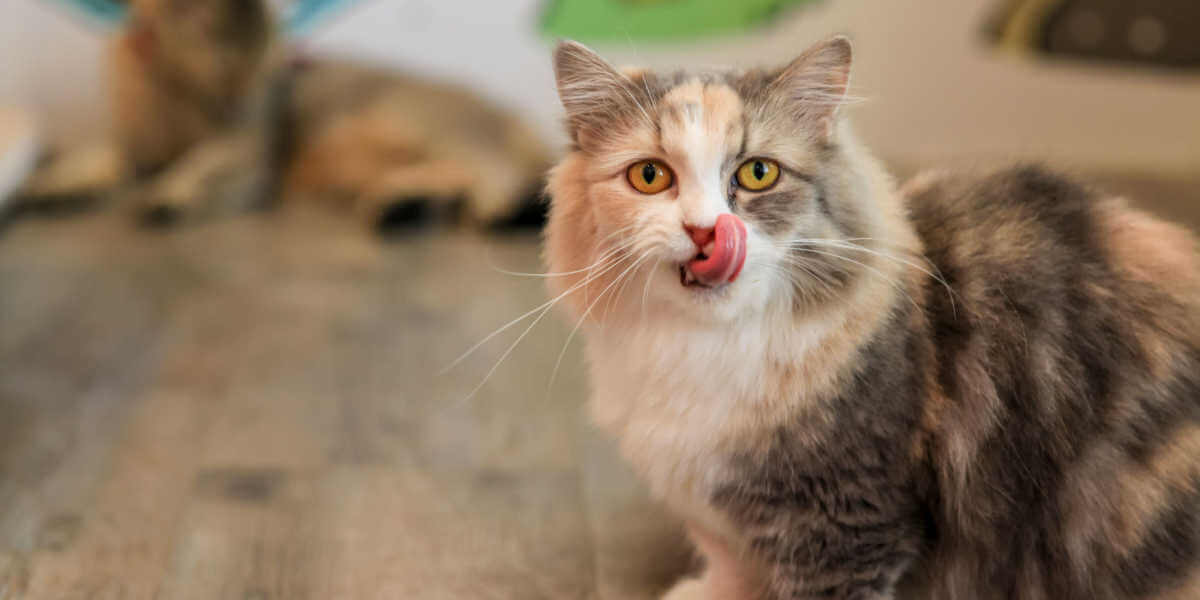
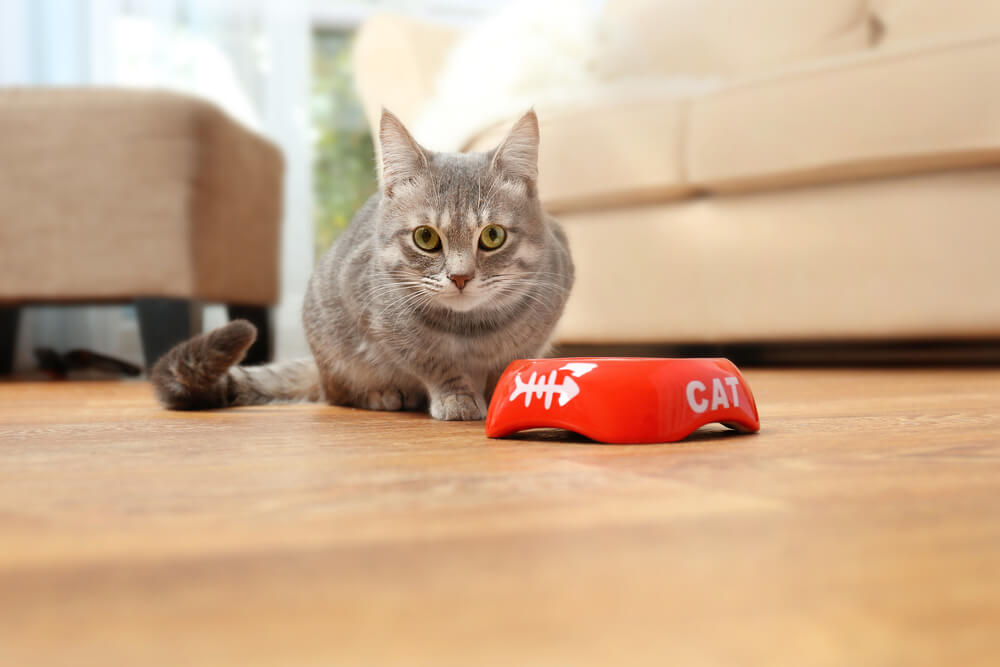
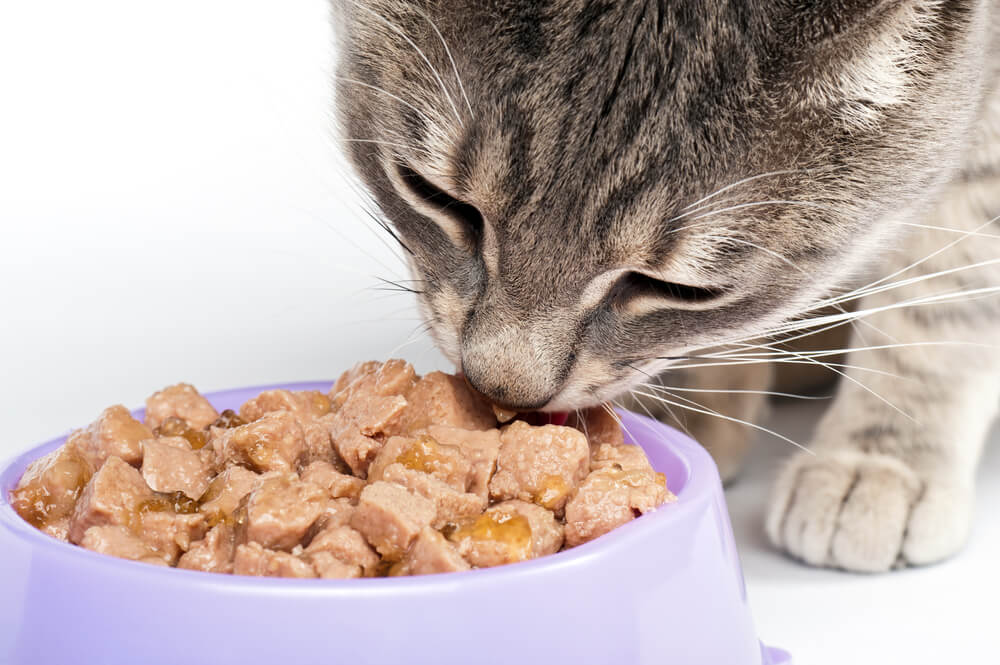
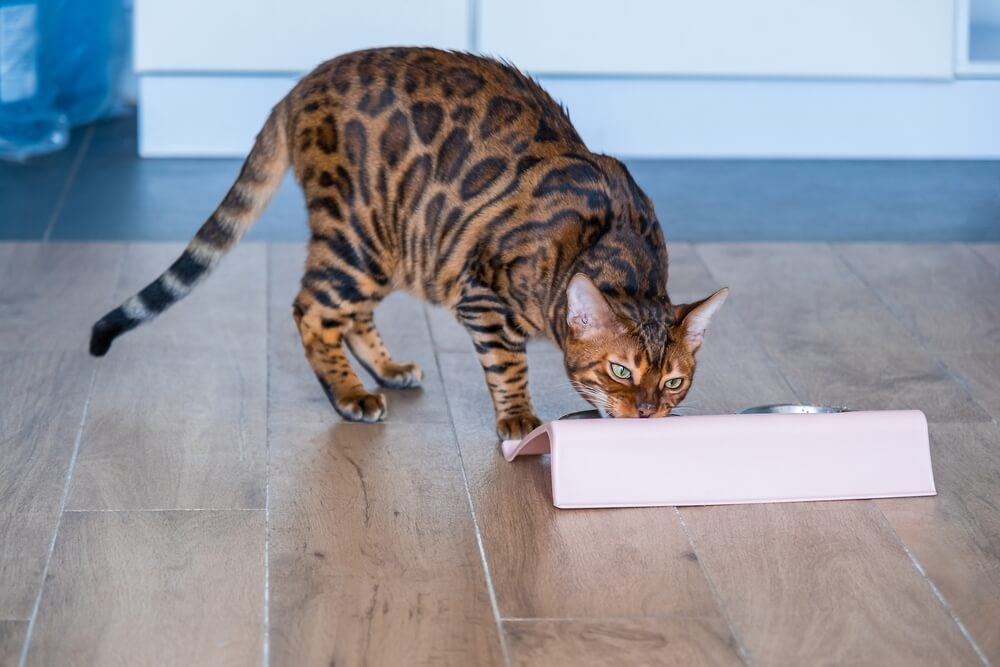
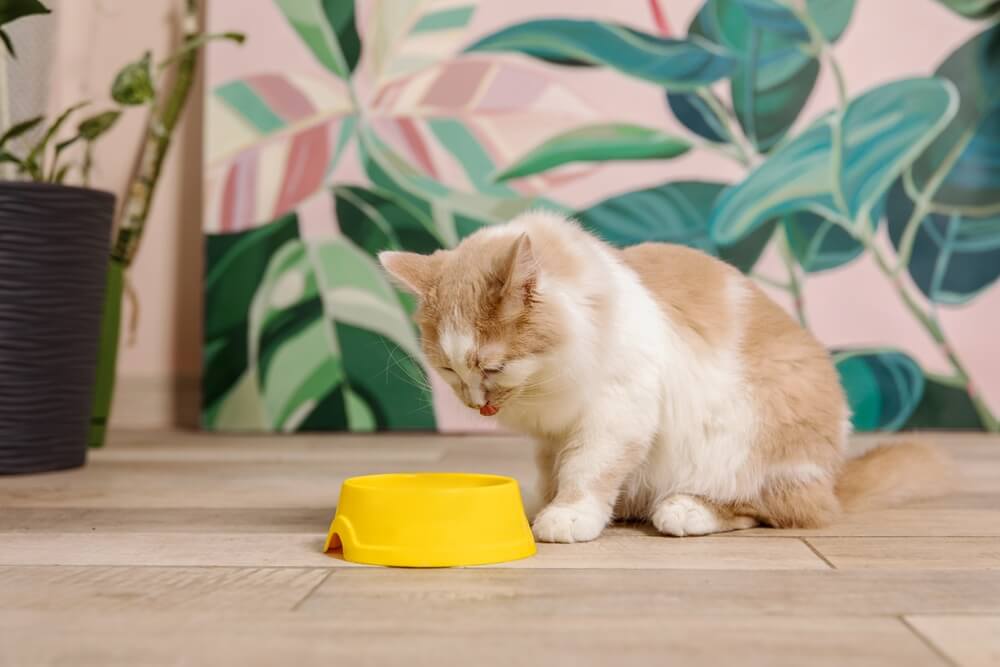
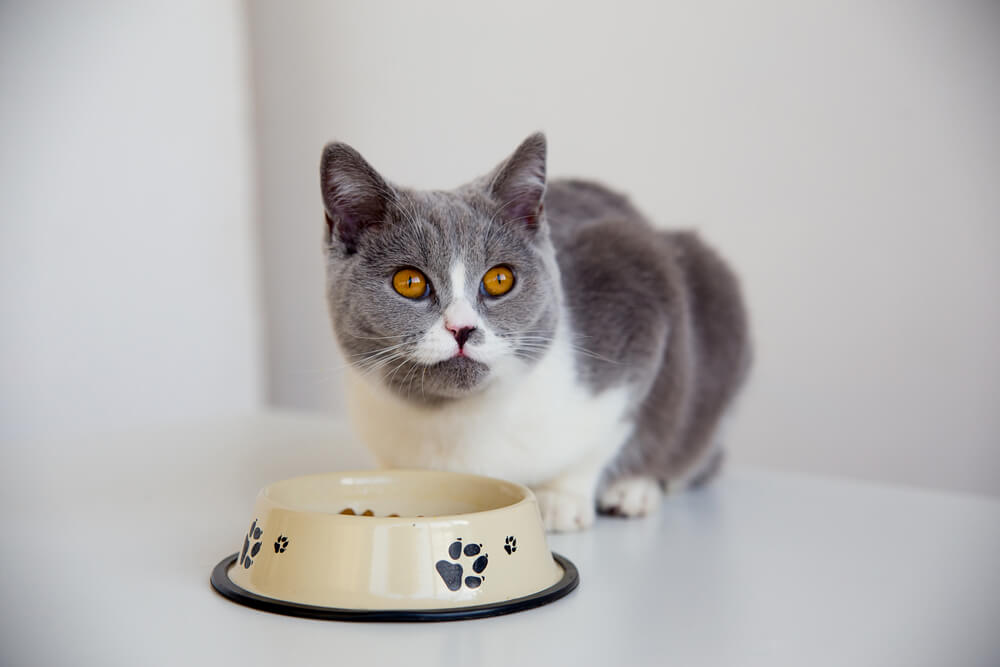
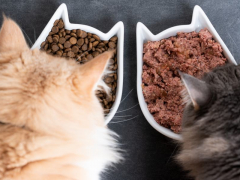
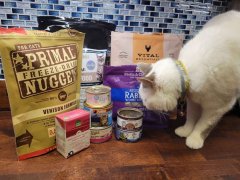
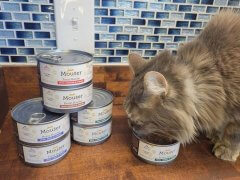
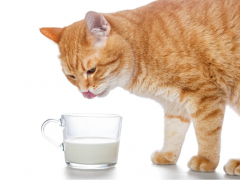
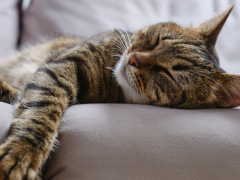
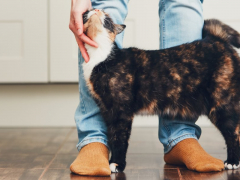

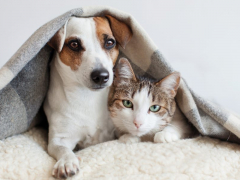
I’m still a bit confused. A cat would never consume 1000 calories in a day so how do I know if my cat is getting enough or too much phosphorus? Is the minimum an actual minimum that they should get of 0.4g a day regardless of the number of calories consumed or is this only a minimum if a cat were to consume 1000 calories and should actually be broken down to the amount they eat? Per my vets recommendation, my cats eat less than 200 calories in a day so does that mean that based on the portion of food they eat, they should not exceed these:
Adult Cats: Recommended Daily Allowance: 0.12g/200kcal
Minimum Allowance: 0.0.8g/200kcal
Adult Cats: Minimum Allowance: 0.1% dry matter for 200kcal
Also how do I know if the breakdown provided by the manufacturer is accounting for the 1000kcal or if it is per can which could be closer to 200 calories? They have the breakdown listed a few ways which are confusing:
1. As fed percentage (as fed measures nutrients based upon their overall percentage in a formula)
2. Dry Matter Analysis (Dry Matter measures nutrients based upon their overall percentage in a formula after the moisture content has been removed)
3. Mineral per 100Kcal
Currently, I am feeding my cats Koha cat food and was told it is high in phosphorous so I am trying to review the cans to see if either the amount I feed them is a problem or if the brand is a problem.
Can you help me better understand?
Hi Kallie,
I see what you’re trying to do by calculating how many grams of phosphorus your cats should be consuming per day. But instead, let’s get the phosphorus amount of the diet expressed in a way that matches with how the different research studies have been conducted. That will be easier to compare and see if there are concerns.
I had a look at the Koha diets. Unlike many, they actually provide a lot more nutritional detail, especially for mineral content, so kudos to them.
In much of the research that I referenced in the article, they were looking at grams per 1000 kilocalories of metabolizable energy (g/1000kcal ME). Diets containing greater than 3.6g/1000kcal ME were found to be more likely detrimental to kidney function.
In the tables you’ve been looking at for the Koha foods, they express the phosphorus content in three ways as you mentioned.
The “as fed” percentage is the percentage in the entire can. The “dry matter” basis allows for a way to compare some diets to each other by removing moisture from the equation.
While AAFCO does provide guidelines for percentage of phosphorus on a dry matter basis, it only provides minimums, so that won’t be helpful for us here.
I think the most helpful of the three for you will be the mineral per 100kcal. We should be able to convert this to the g/1000kcal this way:
The chicken pate they list is 266.21mg per 100kcal. First, convert the mg to grams. 266.21mg = 0.26621 grams.
For the next part, lets put the 0.26621g over 100kcal as a fraction and make it equal to x over 1000kcal as a fraction. This makes us divide 0.26621g by 100kcal, getting 0.0026621 equal to x over 1000. We then multiply 0.0026621 by 1000 from the other side of the equation. This gives us x = 2.6.
So it looks like for the chicken pate, the phosphorus content is 2.6g/1000kcal. This is less than the 3.6g/1000kcal that was found to be the threshold of concern in the research studies. The turkey formulation has the highest amount of phosphorus, coming in at 3.1g.
I did not see any sodium salt phosphates in the food ingredients list, which is promising. Looking in the dry matter basis table, you can divide the calcium percentage by the phosphorus percentage and you get 1.5, which is the calcium to phosphorus ratio. As long as this is greater than 1, we have a good ratio.
Based on the research so far, this particular diet does not appear to have three of the biggest concerns that recent research has shown to be detrimental to cats’ kidneys.
I hope that’s helpful to you.
Hello Dr. Vanderhoof,
I hope you are doing well, and I was wondering what foods do you feed your cats?
Thank you in advance!
Hi M,
Thanks for the question, though I don’t know how helpful my answer will be!
My two cats are both older and special cases. Annie has inflammatory bowel disease. After a little trial and error with different prescription diets, we found a happy medium with Royal Canin HP which she really likes and helps control her symptoms very well. Bart has a history of urinary issues. In order to keep things simple, I now keep him on the Royal Canin HP as well, since it has the struvite/ox shield to protect against urinary crystals and bladder stones.
Hello again Dr. Vanderhoof,
Thank you so much for your reply! I sincerely appreciate you taking the time to answer my question. I am in a similar situation, but I have one dog (Francois) and 11 cats (Baby, Topo, Mama, Olive, Ocelotta, Miss Frizzy, Percy, Cissy, Clyde, Clovis, and Cinnamon.) They range in age from 15 to 4 years of age, four of them are siblings, and all were strays my mom and I took in through the years. We are located in North Carolina, near the Virginia border. My mother passed away last October of ovarian and peritoneal cancer, and I took over the care of all of our animals. Since her death, I have lost 3 of our cats: Pickles to squamous cell carcinoma last November, Whiskey to diabetes in May (whom we surmised was genetically predisposed to diabetes – his sister and father also passed away from diabetes), and Little Man this week to megacolon issues.
I have 2 senior cats who have IBD (Topo and Olive), two cats who have allergies (Cissy and Percy), and two senior cats who have had frequent UTIs in the past (Mama who is the mother of two of the cats who passed away from diabetes and her daughter Ocelotta who is the sister and daughter of the three cats who passed away from diabetes). Topo has had chronic diarrhea recently and is taking prednisone and other meds along with a veterinary EN food in an effort to get things under control again. I am trying to keep my remaining animals healthy as I don’t want to lose anyone else anytime soon, so I have done a lot of research, but all foods seem to have their problems. I have asked my veterinarian for guidance but unfortunately, she admits herself she is not one who can offer much information about animal nutrition.
I have 3 male cats under the age of 8 whom my veterinarian said could be susceptible to blockages (they have had no troubles yet nor have they had any UTIs, but she said if neutered male cats are under the age of 8 they are at risk, she said blockages are not typically seen after that age), so, as a preventative measure, she told me I could give everyone Hill’s Science Diet c/d (several people on the staff at the animal hospital do this with their own animals, including one of the doctors) but I worry about all of them being on a prescription food long term, especially if they currently don’t have any issues.
The Hill’s c/d makes them drink a lot of water and urinate a lot – I wonder if it is safe for their kidneys.
I am trying to be proactive, but they do not seem to enjoy this c/d food as much as their old Purina food, so I am tempted at times to give them the Purina as a treat, but I have read in various food reviews that Purina causes crystals in many cats and there have been many reports of cats becoming very ill or dying from Purina foods recently. I have had some bad experiences myself with Purina as it seemed to cause a lot of digestive issues in my cats, including diarrhea and vomiting. Many years ago, my cat Alexis became blocked, and it was one of the worst things I have ever been through with an animal. There were no special diets in those days and after being unblocked two times, my mom and I decided to relieve him of his suffering. I am so afraid of that happening again.
Are there any non-prescription dry cat food brands you trust and recommend which might also protect their urinary health? (They love dry food and do not want to give it up.) I am also trying to put some weight on my seniors and offer more wet foods – are there any senior or wet food brands you recommend Dr. Vanderhoof? I have read IBD patients should avoid guar gum but it is in so many wet cat foods. Also, I have a very picky 13 year old dog who has no health issues – are there any foods you could recommend for him, dry and/or wet?
I have read some animals are given the best foods and still die relatively young, while other animals, like my stepfather’s male cat, are given Special Kitty (Walmart brand) and live until 21 with no issues. My uncle and grandmother tell me no matter what I do there may be nothing I can do to save them if it is their time which I understand, but I do not want to create or contribute to any health issues by making poor choices. I would never forgive myself if one of my cats became blocked again. It is a lot of pressure having so many lives depending on you for their well-being. I am worrying so much about their food and keeping them well that I am absolutely exhausted all of the time and currently I am spending more time researching foods online than spending time with them. I want this to change, it’s just I am so desperate to find some peace of mind. After losing my mom and my feline companions I am so worried about keeping them healthy and I don’t want to give them anything that will cause them harm. Thank you so much Dr. Vanderhoof and all my best to you, Annie, and Bart!
Dr. Vanderhoof,
I forgot to add, the Purina food that my cats love but which also makes my cats regurgitate shortly after eating and causes awful diarrhea is Purina One Tender Selects Chicken. One of my IBD cats passed that food undigested. My vet recommended it as an affordable option as she does not think grain free foods are healthy and Purina One has chicken as the first ingredient, but I brought it to her attention that this food also has 3 forms of soy in it (which she was not aware of, she said it was disappointing). I have heard soy in cat food is suspected of causing thyroid issues in cats. Also, with the Hill’s Urinary Care c/d food I am seeing an increase in hairballs and some vomiting as well in the healthy cats and now I don’t know what to feed the healthy cats who have no issues. I am just looking for reputable brands (dry and wet) that my healthy cats will enjoy. Any suggestions would be sincerely appreciated. Thank you again Dr. Vanderhoof.
Hi M,
It sounds like you have a lot on your plate. I’m sorry to hear of your recent loss of one of your kitties.
There are a couple of important things to understand and accept about caring for animals. First, we never truly have absolute control over what happens to them. We can certainly mitigate some risks, but cannot control all outcomes.
Second, every animal is an individual, so there is no one universal food or other approach to care that will work for everyone.
As an example for my own cats. I had three initially, all littermates. When they were young, I had all three on a good quality holistic brand of food. Around 4 years, Teach developed a bladder stone. I changed them all over to a prescription urinary diet for several years.
Around 6 years, Teach developed nasal lymphoma. He was treated and did well for another 6 years until he passed away from another, untreatable nasal cancer.
Annie developed IBD around age 12, which is when I changed her to the Royal Canin HP. Also around age 12, Bart developed hyperthyroidism, which he has since been treated for.
My point in sharing this about them is that I have three cats all from the same litter, all on the same food, living in the same environment. And yet they all developed different diseases at different times. There are very subtle differences in the physiology of every animal that makes it impossible to predict exactly what will happen. That’s why some cats can eat a poor quality diet and live longer than another cat on a very expensive high quality diet.
Anytime I discuss food choices with a client for their pet, it’s a very individual discussion and there is often a trial and error process associated with it. I generally don’t make blanket recommendations for foods or brands because inevitably there are pets these recommendations won’t work for.
Nutrition is very complex. Doing research on your own can lead you down a very deep rabbit hole. There are very few true nutritional experts out there compared to how many people have strong opinions about nutrition. Always make sure that anything you find is supported by actual research studies and remember that research in many areas is ongoing.
When addressing specific medical disorders as a couple of your cats have, I do feel prescription diets can be very helpful. They must be strictly formulated. Non-prescription diets can be more variable and there is more flexibility with labeling requirements. That makes it hard to say that a non-prescription food will address a medical disorder adequately, since it is not really made for that purpose.
I think your vet is doing their best to provide good guidance. We all have more background in nutrition than the average, but not as much expertise as a veterinary nutritionist. Even I have to look up things or look into some specific diets more.
Always actively seek to spend that quality time with your pets. It can be very easy to go down that rabbit hole with reading things online endlessly and lose sight of actively seeking our personal connections with loved ones, including our pets.
Hi Dr. Vanderhoof, both of my 4 year old brothers have slightly elevated kidney values from yearly blood work. I’d like to get a handle on it quickly and feel offering a canned or raw food low in Phosphorus might do the trick. Does Royal Cannin or Hills provide species appropriate ingredients in their prescription food? Based on all the helpful information I’ve been reading about regarding what constitutes an appropriate diet, they do not. I would appreciate your advice on this. Thank you. Trying to do my best for my young boys.
Hi Jacque,
Thanks for your question. Before getting too deep into a major diet change, I would make sure that the slightly elevated kidney values you’re seeing in the annual lab work is truly related to kidney disease. This is not always the case. If you’re referring to BUN and Creatinine, you always have to compare these to a urine sample. If a cat’s urine is still normally concentrated, then the kidneys are functioning just fine.
If there are mild elevations with normal urine concentration (usually greater than 1.035-1.040) this may be what we call pre-renal azotemia. As the name pre-renal indicates, this is not related to kidney dysfunction. Dehydration can be a common cause in this case.
If it’s not clear, then SDMA is a newer value that can be used to detect true kidney disease as much as possible.
In cats that don’t have true kidney disease but may have pre-renal azotemia on labwork, one focus can be on finding ways to increase water intake either through water-seeking strategies like water fountains or with higher proportions of canned/moist food.
If it has been confirmed with either or both methods that true kidney disease exists, then the best general advice is for a prescription diet for early stage kidney disease, as this is really the only reliable way to be certain about phosphorus restriction, which we know is the most important.
Here is a quote from the article about the difference between OTC diets, which are the main concern for unpredictable phosphorus levels, and prescription veterinary diets:
“In addition, ingredient labels often list minimum amounts of nutrients to ensure against deficiencies. But maximums are less commonly included and until safe maximums are firmly established for phosphorus, pet parents will have no idea what the phosphorus level in the diet actually is.
The only exception is for prescription veterinary diets with formulation for pets with kidney disease. These renal diets must be formulated to have a limited maximum amount of phosphorus (and a minimum level of calcium), and you will find these minimum and maximum percentages in the Guaranteed Analysis section of these diets.”
I don’t know what is referred to by “species appropriate ingredients”. The prescription diets for renal disease are formulated to meet the nutritional needs of cats and unlike with OTC diets, phosphorus levels must be kept within a narrow window. They are required to. The complexity and number of ingredients involved in formulation of commercial diets has led plenty of folks to distrust them, but that alone does not make them inappropriate diets.
For cats with early stage true kidney disease, we do know that protein restriction is not necessary and the focus is truly phosphorus, along with the correct calcium to phosphorus ratio (detailed more in the article). For prescription diets, it’s important to look at the early stage kidney disease formulations that are predominantly just restricted in phosphorus.
I have said before that there are many people with opinions on nutrition and very few experts. You will read many opinions about what cats should be eating, including raw diets. Raw diets are not any more “natural” than traditional commercial diets, as they are still human creations. They are just another diet choice with their own advantages and disadvantages. Their one advantage may be in the lack of phosphate preservatives, which I talk about in a lot more detail in the article. But home-made diets are almost certain to be lacking in full nutritional balance, which is crucial for cats even more so than dogs. They are also higher in organic phosphorus, and we don’t fully understand how high levels of organic phosphorus impact kidney function over time.
Apologies for the long answer, but I hope that is helpful.
Thank you for the quick response. Yes, that all is very helpful and I appreciate the details. Thank you very much.
Hi there,
My ragdoll was found unilateral renal agisenes at 1 year old and now I’m pretty anxious about her health. Is it important to choose low phosphorus cat food(either wet or dry) to protect her only one kidney from now? I’ve changed the wet food to low phosphorus, but having trouble to choose the dry food(it’s hard to find one that is 0 grain&high protein but low phosphorus)… If you could give some suggestions will be much appreciated.
Thanks,
Tim
Hi Tim,
We know that one kidney can do the job of two and usually most cats with kidney disease are likely affected in both kidneys anyway. So I don’t know that your kitty is at higher risk, but your concern is valid.
I hope that in the next year or two we’ll be seeing foods with labeling that is more clear, especially in terms of phosphorus content. As the article mentions, there has been a lot of research recently that should be driving these changes.
My best advice for now would be to follow the guidelines provided in the article, looking to avoid diets with inorganic phosphates, especially sodium-based phosphate salts.
The fresh-made delivery diets listed in the article may also be reasonable choices as they have limited or no preservatives, removing the concern about inorganic phosphates.
It may be reasonable, if there is a perceived higher risk, even if there is no kidney disease present yet, to consider one of the early kidney support prescription diets. Hill’s and Royal Canin both make one. The only thing limited is the sodium and phosphorus levels and they are required to stay under a certain level. Protein levels are not reduced in the early care diets.
As a prescription diet, you would need to discuss with your vet. Some vets may disagree in a cat so young, but that is one way to be certain of low dietary phosphorus levels.
Hi Dr.Chris,
Thank you a lot for answering it so timely. Same idea for “foods with labeling that is more clear”. And one more question for drinking water, I’m hearing that enough water intake could also keep kidney healthy. But just confused what if too much water intake could also increase kidney loading and cause kidney damage(at present my cat doesn’t like to drink much, but just a further concern), is this concern valid? Hope I illustrated my question clearly since I’m not a native English speaker…
Thanks,
Teng
Hi Tim. Cats naturally are able to conserve water far more efficiently than humans or dogs can, and so it is not uncommon to rarely see your cat drink. This can be normal. A cat that spends too much time at the water bowl is more concerning. While we don’t often think of them this way, the ancestors of our current housecats were well-adapted to arid conditions as desert animals. Hence why we see such reverence in Egyptian culture for cats.
That said, cats do have a fascination with flowing water. Increasing regular water consumption can be achieved with a cat water fountain. Providing canned food also helps provide good water intake as well. Providing more fluid intake opportunity this way does not contribute to any stress on the kidneys.
Hi Dr.Chris,
Sorry to add one more question…What percentage of phosphorus you could consider as low phosphorus for dry cat food?
Thanks,
Tim
This is a good question Tim, because, as I highlighted in the article, there has been a lot of recent research about what the safe threshold for phosphorus content in cat food is. Research has generally pointed to the 3.6 grams of phosphorus per 1000 kilocalories of metabolizable energy. You may not see it expressed this way on foods, but you can look at the first post for this article where I did some conversions to help another cat parent figure out the phosphorus content in their cat’s food.
The phosphorus content may also be expressed as a percentage of dry matter. Much of the research did not express phosphorus levels in food in this way, but we could look at some of the prescription diets to see what their veterinary nutritionists consider a low phosphorus content. The Hill’s early renal support is 0.55%. The Royal Canin version is similar at 0.5%. The Hill’s standard k/d renal diet is 0.54%. The Royal Canin standard renal support diet is 0.3%. So it at least appears that when looking at the percentage of dry matter, we’re likely looking for about 0.5% or less for a “low” phosphorus diet.
Just remember to keep in mind that other factors, like the type of phosphorus (organic vs. inorganic) and the calcium to phoshporus ratio (which should exceed 1) are important as well.
Thank you so much for writing this article. I was actually able to find out which food I was giving that was giving my poor cat urinary issues. It turned out to be a freeze dried raw that contained sodium phosphates w/ a 1.85% phosphorus DM. I cannot thank you enough.
You’re welcome Vanessa, I’m glad it was so helpful for you.
the conversion of 3.6g/1000kcals to DM% would be extremely useful to know because companies disclose the amount of nutrients in food by DM% a lot of the times in the US (if they even provide the nutrient profile). Please correct me if I’m wrong but from what I calculated 3.6g/1000kcal converts to 1.44% DM. This value would be super useful to know especially when shopping for a new food for the fur babies.
You can’t simply convert g/1000kcal ME to DM% generically, as these are measurements of two completely different things. One being energy content, the other simply being the percentage of an ingredient compared to others, minus moisture content.
The guaranteed analysis percentages found on most labels are as fed percentages by convention (unless they specifically say dry matter %, which some do, but not most). Each food has a different moisture content that has to be removed to determine DM%. The moisture percentage is usually listed on packaging, but you’d have to have that value, plus the calorie content of the food in kcal/kg, to be able to convert between those values for a particular diet.
It certainly can get confusing, but you can have two diets that both have, say, 3.0g/1000kcal ME of phosphorus but the % of phosphorus on a dry matter basis may still end up being different because the moisture contents are different.
Conversely you may have two diets with the same percent of phosphorus on a DM basis, but once you add back in moisture content, you’re likely going to have a different amount of phosphorus based on energy content of the diet.
I see. Fromm has a “Typical Analysis” that contains a nutrient profile of their foods on their website. Using the chicken & duck pate as an example (1,142 kcal/kg, moisture 78% max (so 22% DM?) , 0.29% phosphorus as fed basis, 1.26% DM phosphorus), could I and how would I determine g of phosphorus per 1000 kcals? I’m not sure if this is correct but I calculated 2.42g of P / 1000 kcals.
(0.22/1 • 0.0126/1 • 0.8757 kg/1000 kcal • 1000g/1kg) – I changed the 1 kg/1,142 kcals to a denominator of 1000kcals. Thank you for your time
Looks like you got it! It’ll be slightly different whether you use the as fed % of 0.29 (with a subsequent dry matter of 1.3%) vs. the 1.26%DM they list, but you have all the steps correct (calculate it with the 0.29% AF and you’ll get 2.5g/1000kcal. If you’re trying to compare diets and you don’t want to do all the math yourself, you can use this handy calculator from Tufts Nutrition (it’s at the bottom of the article): https://vetnutrition.tufts.edu/2017/08/nutrient_converter/
Thank you so much for all your help. I truly appreciate it 😀